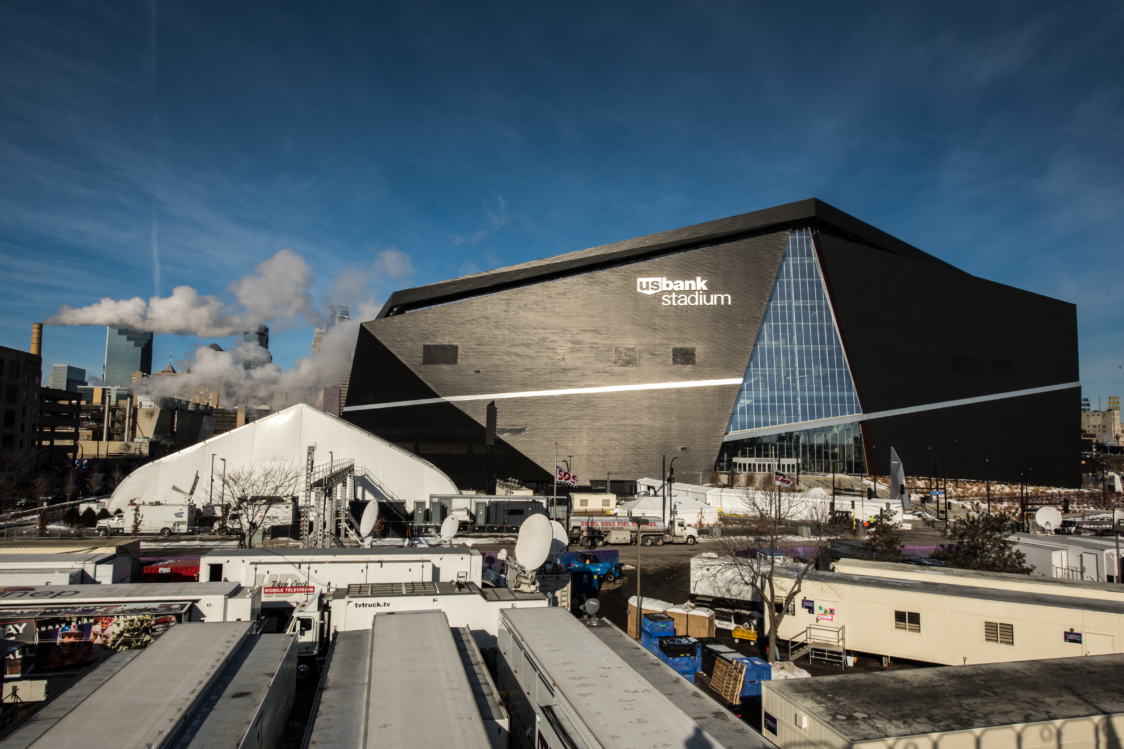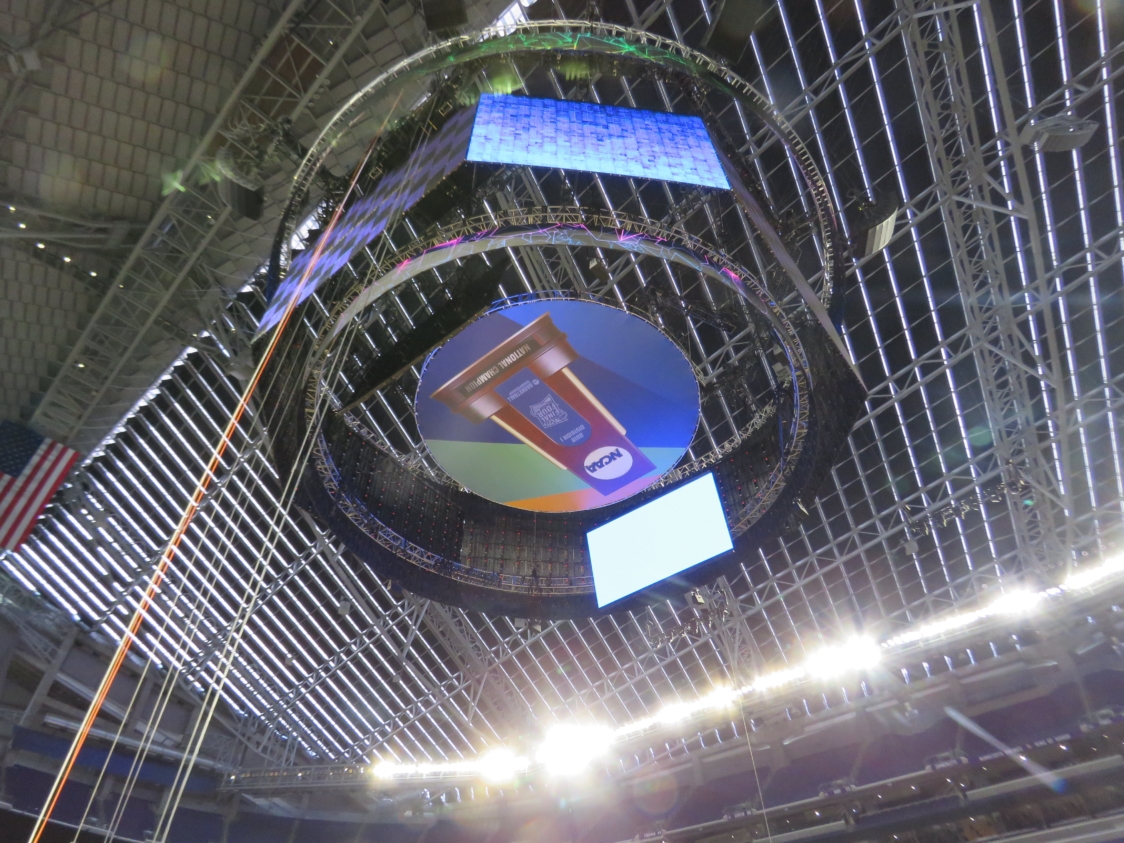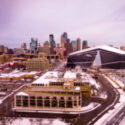The Minnesota Vikings’ home stadium wasn’t just built for football, nor was it built as a stadium of yesteryear. From being built with lightweight material, to features designed for zero-waste operation, U.S. Bank Stadium has set a new standard for venue design and operation.
Midwestern cities often get a bad rap for their size, population, industries and building size. Minneapolis, MN, is under-appreciated to the same tune. The skyline is striking, with a “real” city’s worth of skyscrapers and bold glass structures akin to iconic American cities like Chicago, LA and New York.
Mixed into that skyline is U.S. Bank Stadium, the new home of the NFL’s Minnesota Vikings, and host to the 2018 Super Bowl and the 2019 NCAA Men’s Final Four. And while it holds the silhouette of a sort of battleship-looking gargantuan, the stadium is a stunning piece of architecture that breaks away from the traditional aesthetic of football stadiums.
But all that beauty serves a purpose, as US Bank Stadium was built to be used often, for the largest events in the nation and to do so sustainably. “I like to think of our stadiums as being iPhones, because they’re always being updated…” says Lance Evans, Associate Principal and Senior Vice President at HKS, Inc. “[U.S. Bank Stadium] is one of the pieces of architecture I’m the proudest of.”
“I like to think of our stadiums as being iPhones, because they’re always being updated…[U.S. Bank Stadium] is one of the pieces of architecture I’m the proudest of.”
Lance Evans, Associate Principal and Senior Vice President at HKS, Inc.
Sustainable design
Designed by HKS, Inc., U.S. Bank Stadium was just the second LEED Gold certified host of the Super Bowl in 2018. The building cost $1.1 billion to complete over the course of 30 months of construction.

LEED (Leadership in Energy and Environmental Design) is the most popular green building rating system in the world, provided by the U.S. Green Building Council. It is a 110-point, four-tier scale; having certain sustainable elements in the design earns points which are totaled up for a score. The tiers are Certified, Silver, Gold and Platinum.
U.S. Bank Stadium earned a Gold certification, meaning that it scored between 60-79 points on the scale. The first stadium in the U.S. to earn a Platinum certification was Mercedes-Benz Stadium in Atlanta, Georgia, built by HOK architects.
One of U.S. Bank Stadium’s best green features is the roof, which is made of transparent ethylene-tetrafluoroethylene (ETFE). ETFE is a see-through glass-like material used for the windows and roof. While it is just as durable, glass weighs one-hundred times more than ETFE. This makes the roof load much lighter, requiring less steel to support it. This material also helps for a couple of other reasons particularly handy in a north-Midwestern climate.
“The roof holds gutters, that are unable to be seen by onlookers, which are 45 feet deep to help with the snow,” says Evans. “The material and angles of the roof help snow slide right off with the heat of the building.”
There was certainly reason for snow removal to be an issue of concern for the new design. In 2010, the roof the the Metrodome (previous home to the Minnesota Vikings) collapsed under the weight of snow during a winter storm.
Aside from sustainable elements in the design, U.S. Bank Stadium is also operated with a focus on limiting waste, which earned it recognition as the Green Sports Alliance’s Innovators of the Year in 2018.
When hosting the Super Bowl in 2018, U.S. Bank Stadium ran the first ever “Zero Waste” campaign with 91% of all waste from the event being recycled. While not every event is run nearly as organized as the Super Bowl, in which hundreds of workers were hired to sort recyclable goods after the game, management makes efforts to divert waste, save energy, collect stormwater and reduce wasteful transportation near the stadium with the goal being zero waste.
“The Zero Waste Super Bowl was our launching pad for zero-waste operations,” says Patrick Talty, General Manager of U.S. Bank Stadium. “We strive to operate at zero waste at all times; we’re recycling as much as we can and we’re working very hard on our sustainability all the time.”
Despite the nature of the event the stadium is hosting, sustainability efforts are constantly being made. With the recognition the stadium has received, it has soon become well-booked and has no shortage of events headed its way.
Stadium alterations to host the Final Four
U.S. Bank Stadium was built to hold a wide array of events, but hosting the Final Four presented some unique challenges for event organizers.
Football is an outdoor sport, with lots of bright light involved. Many stadiums are outdoors or feature glass, or retractable, roofs to let in more natural light – including U.S. Bank Stadium.
With a stadium roof and exterior made up mostly of see-through materials, darkening solutions were needed to make sure on-court conditions would be consistent regardless of the time of day and amount of light outside the stadium.

“One of our hallmark features is our sunlight, and making it feel like the outside,” says Talty. “That’s something we had to change for these games because lighting conditions need to be equal for all four teams.”
The solution to this lighting challenge was to hang many tons of fabric from the ceiling and walls of the arena. 225,000 square feet of fabric were hung from 75 roof bays to block out light from overhead. On the walls, 7.1 miles of fabric, weighing 16,000 pounds, were suspended to prevent glare and shadows during primetime games played during sunsets.
With lighting taken care of, an extra 18,000 seats were installed to bring seating closer to the court – as the stadiums regular set-up is intended for football. This brought the stadium’s capacity up to 72,000 patrons for the Final Four.
Getting put to use
The first major event U.S. Bank Stadium hosted was an international Champions Cup soccer event, between A.C. Milan and Chelsea F.C. on August 3, 2016. Since then, it has held national soccer matches, concerts, Monster Jam, ESPN Summer X Games, car shows, AMA Supercross, Taylor Swift, the Final Four in April of 2019 and will host the NCAA Wrestling Championships in March of 2020.
Photos by Groveland Media, U.S. Immigration and Customs Enforcement and Cathryn Cheek.

